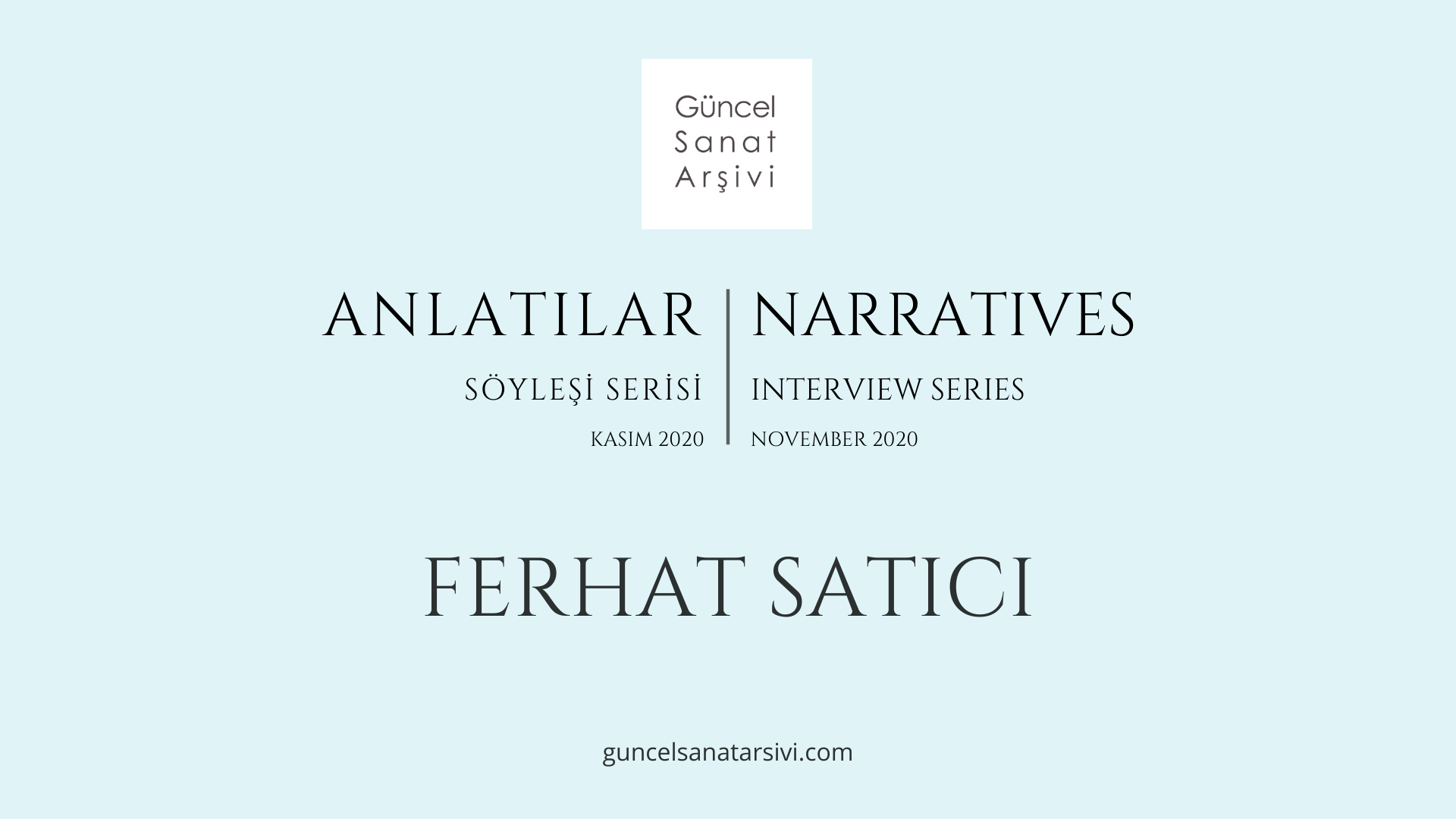Interview: Seniha Ünay / About
Translation: Burçin Nilay Kalınbayrak / About
The guest of the November issue of Narratives Interview Series is the artist and academician Ferhat Satıcı (Yeni Anıt / The New Colossus), who produces in different mediums such as sculpture, video, painting, and installation between the permanence of the monumental and the temporality of the casual. We had the opportunity to talk about his pseudonym “Yeni Anıt”, his role in the Videoist Initiative, and his production process.
“I produce artworks with different materials revealing the layers and the mystery beyond the visible, by keeping the sculpture in the center.“
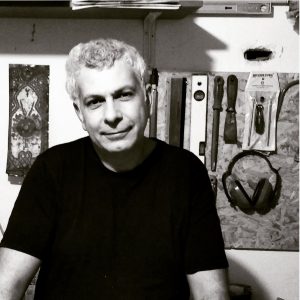
You are using the pseudonym “Yeni Anıt (The New Colossus)”. Generally, Divan Literature and Turkish Literature poet-singers may use pseudonyms and some artists may be known both by their names and their pseudonyms. Especially, street artists use pseudonyms to hide their identities.
Besides, “Yeni Anıt” calls some meanings to our minds. One of these is the meaning of “colossus”, which has become traditional for centuries, that is “a monumental work demonstrating an important event with a historical feature.” The other is the meaning of “new” which is “something that has not been long since its existence or emergence.” You add the word “new” before the word “colossus” of which the meaning is established in our minds. Can we say that this expression you chose creates a connotation between the traditional and the new? Can a relation be established between this choice and being a sculpture based artist? What is your purpose for using a pseudonym and the story behind it?
It would not be so wrong to answer this question as “I read a book and my life has changed.” “Yeni Anıt” was the title of the book written by the character named Benjamin Sachs in Paul Auster’s book “Leviathan”. Sachs, a poet, a writer, an eccentric man who believes in coincidences, was gathering all kinds of information and turning documented facts into fiction, seeing the world as something imaginary. In his narrative that you embark on a journey in the expanding universe of coincidences and connotations, Paul Auster makes you feel that a book is a mysterious object, something that causes coincidences and layers of meaning just like humans. You witness the birth or disappearance of the writer again and again in the actions of or in the book written by the character who is in the writer’s own story. Here, an uncertainty occurs between existence, ego, the author, and the recipient in line with the subject-object. First of all, this story lies at the basis of why I use a pseudonym and chose this one which is between the permanence of the monumental and the temporality of the casual. Here, the pseudonym does not hide my name as street performers do. You may also see my name on my projects from time to time. “Yeni Anıt” came into being because breaking the ordinary system between the work, the artist, and the recipient strengthens the idea that the work may have a personality like the person who made it. It points to a collective mind and an anonymous artistic approach based on the idea that the works can also be born, live, and die as an alternative to the idea that they cannot be thought independent of their artists. In an environment where this kind of individuation and egocentrism prowl around, “Yeni Anıt” wants to point out the spiritual and latent nature of the artwork, even if it does not make it possible completely for it to exist in a nonmarket arena.

Yeni Anıt, “Öktem’s Nightmare: Dignity of the Digging“, 3. Çanakkale Biennial, 28.09-03.11.2012.
In your “Sculptor’s Nightmare” series, you fictionalize the news, which determines our daily life and even become ordinary, as if they are historical victory scenes. Your work, “2010 Offspace Odyssey Istanbul” is based on the history and legends of the city. In your work “Artist‘s Declaration of Property”, you tackle the existential features of Videoist. What are the issues that Ferhat Satici (Yeni Anıt) dwells on? What is he affected by, what does he do?
Walter Benjamin’s words, “Allegories are, in the realm of thought, what ruins are in the realm of things” can be used to explain the “Sculptor’s Nightmare” series. The unifying glue that forms the meaning maps of societies passes through allegories. Wars, monumental and magnificent narratives, enlightenment, hope, and praises for victories come into existence in the permanent material of the monument. Carrying the patterns of these high emotions, the sculptor can feel the temporality and slippery structure behind that bright and powerful structure. Since the sculptor knows that the meaning and material constantly change while constructing the monument. In short, the only thing that does not change is the variability of meaning and material. From here, if we go back to Benjamin, narratives in which metaphors transform into allegories by being organized therefore will come to the place of historical ruins in a constant dead-end street. The ruins, on the other hand, are the signs that reveal our true memory. “Sculptor’s Nightmare” series is based on the idea that the sculptor sees a nightmare of a future trauma that he cannot understand which you can call the conscience of the sculpture or the delusion of the artist. This dark riddle, made for the sculptor, can only be understood when time is changed. However, when viewed from today, daily life is presented with repeated iconic dead-ends in a constantly updated mediatic mechanism of destruction.
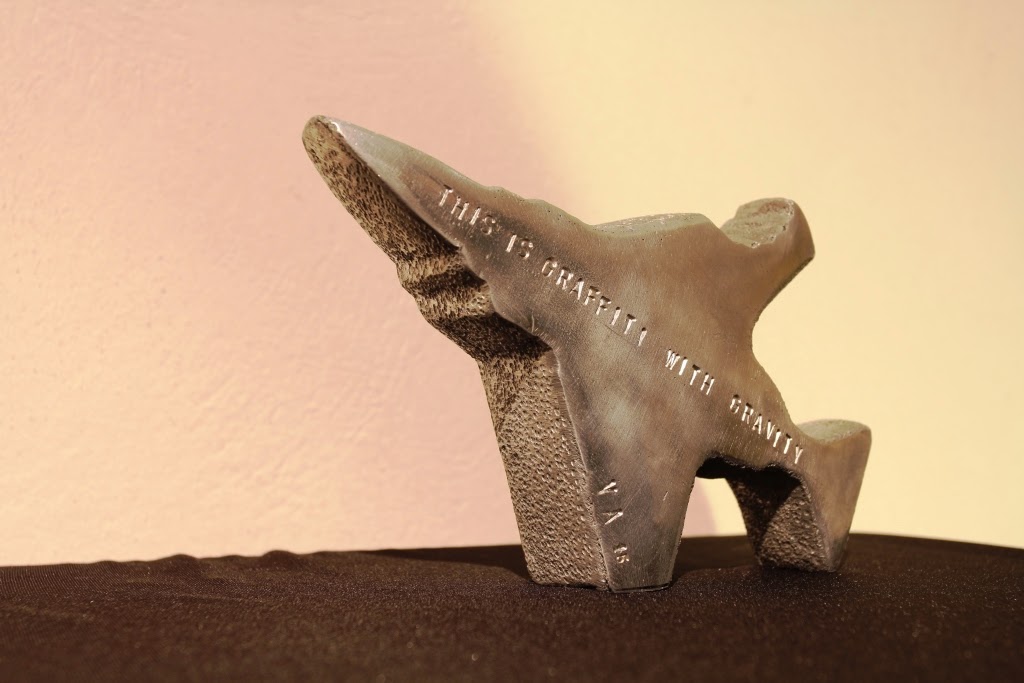
Yeni Anıt, “Phantom“, Sculpture, From the Exhibition “Crossing Axis”, m1886, Ankara, 21.03-26.04.2015.
“2010 Offspace Odyssey Istanbul” brings fiction and reality together with a documentary language in the form of a video fanzine. It reflects an artistic period when I made three-dimensional graffiti sculptures I call “Graffities with Gravity“, and researched street art. My “Street Journal” series is another reflection of this process. The marks and materials constituting the grammar of the city determine our dialogue with the city, an organism in which we live. For me, Istanbul is a city that getting out of its influence is impossible due to its mysterious and multi-layered structure. In this project, by combining cultural and historical codes belonging to my era, I wanted to create an Istanbul narrative and present mystery and reality side by side. I think artworks have the potential to make way for coincidences as books and people do. That’s why I produce artworks with different materials that will reveal the layers and mystery beyond the visible, by keeping the “sculpture” in the center.
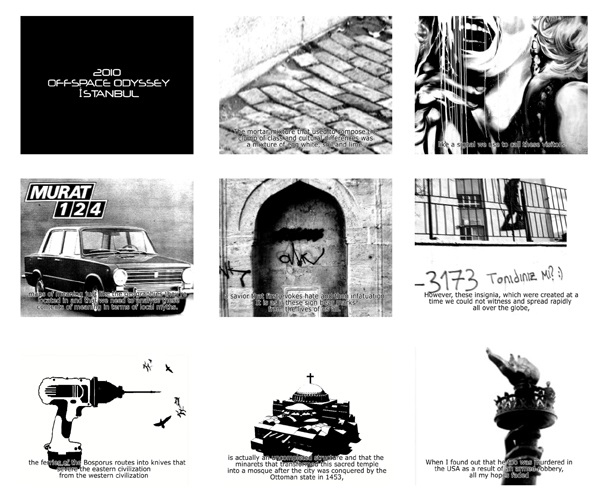
Yeni Anıt, “2010 Offspace Odyssey Istanbul“, Video, 20’07”, 2010. From the Exhibition “Re-degeneration”, Istanbul, 04-17.05.2011.
“Time and space could not be possible with a single ego as the video art production and the Videoist process showed us.”
We see that you include so many different materials and techniques in your works. For example, “Krippel’s Nightmare” is a video art, but you apply the same composition to photography and painting as well. Again, there are photography and painting versions of your installation “Integrity”. You also have sculptures such as “Assembly Fault”, “Torch of Boredom”, “Reality Report”. Could you mention this diversity in your production style and your production process?
The paintings representing the design processes of my works such as “Krippel’s Nightmare” and “Integrity” were transformed into photo and video versions. My production process proceeds as follows: The idea is depicted as a design by the storyboard technique. Then this draft is displayed on city surfaces by being edited like a large advertisement photograph designed to be placed in the public space. Here the photograph is for the frozen sculptural image to meet the recipient on an urban scale. The video version, on the other hand, is the disclosure of the motionless stance or the motion of those who perform the allegory in a sculptural way with a documentary language. In other words, the backstage of the setup. The draft, the scene, and the document constitute the backbone of these works. You can think of them as artworks that complement each other. As you can see, the process is as important to me as the finished work. For example, my sculpture “Assembly Fault” is a document of the scene in which the Maiden’s Tower turns into a drill in my video “2010 Offspace Odyssey Istanbul.” Just like the frames and layers of a movie, you see the different layers transforming into a three-dimensional drill form. It is an artwork where the idea of sculpture and video is fictionalized together or consecutively. This work is based on the idea of sculpture as the projection of “video”. Although my works “Torch of Boredom” and “Reality Report” are in the form of “sculpture” that we are used to, they are based on the idea of “sculpture” as a ready-made object. Coming together of ready-made three-dimensional images with images and materials I designed. As a result, it is aimed to make the “familiar meaning” immigrate by the meeting of the images we are used to with other iconic images.



Yeni Anıt, “Integrity“, Installation, Digital photography and Dry Paint on Paper, Port İzmir 3, Austro-Turk Tobacco House, 2014.
You are opening an exhibition, named ” Time of Sculpture” at Blogspot Art Space in Balıkesir on November 12, 2020. Right after, Hülya Özdemir’s exhibition, named “Space of Video” will be opening at the same venue. As you stated in the exhibition text, this exhibition brings a new perspective to the usual exhibition concept while pointing to your practices of production and thought. Could you tell us about this exhibition form and your exhibition “Time of Sculpture”?
The idea of the exhibition came up with the idea, which we have been discussing with Hülya Özdemir for a long time, that “video” is an interface bringing together many artistic disciplines with its interdisciplinary structure. Underpinning this idea, the exhibition “Unplugged: A Transition from the Fragmented Nature of the Image to a Background Acoustic” in Istanbul in 2010 and the exhibition “Unfold” in Ankara in 2017, demonstrated the potential of the “video” as a background. This time, we built two consecutive solo exhibitions treating the idea of carving time and space, starring the two disciplines “video” and “sculpture”, which are the most extraordinary aspects of the multi-layered structure for us and play a dominant part in our works. Time and space could not be possible with a single ego as the video art production and the Videoist process showed us. We tried to reconstruct the idea of sight within the framework of the transitivity of our works by thinking of two separate minds or one space as two separate brain hemispheres. What Fredric Jameson calls “a statue with blind eyeballs”, what Ulus Baker finds closer to an icon or sculpture rather than a painting or photograph, and what Andrey Tarkovsky calls sculpting in time with dream, time, and water themes was the idea of video, inherited to us from the moving image. Organizing an exhibition that establishes bonds between the idea of video and the idea of sculpture may include a multifaceted view of the image issue, which is the dominant subject of all arts. Here, what makes us who we are and reveals the form of our production of art coincide with our spontaneous self-organizing forms. We designed the exhibition in an unsponsored, non-profit, self-organized, nonconformist, non-commercial, and off-center space, in a way that points to our stance.
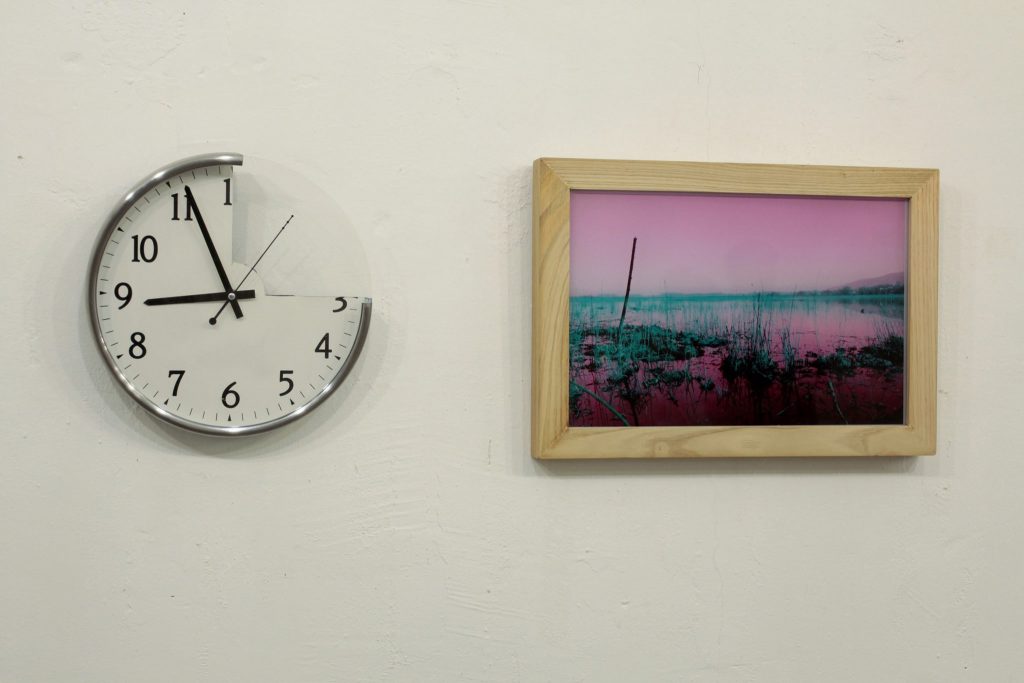
Ferhat Satıcı, “Deposit”, Manipulated wall clock, 2015. “Sprinkle”, Framed uv print, 2018-2020. From the solo exhibition “Time of Sculpture“, Blogspot Art Space, Balıkesir, 12-25.11.2020.
With Hülya Özdemir, you are the co-founder and director of Videoist Art Initiative which has made important contributions to video art in Turkey since 2003. Videoist has an important archive of video art, and here, as an artist, you both make the selections and decide the exhibition form. Sometimes you appear as a participant artist in Videoist exhibitions as well. Could you touch on these two roles of yours in Videoist and your process of working and thinking together?
Since 2003, Videoist organized various events centering video art, a contemporary art medium rising in Turkey and the world throughout the 1990s and 2000s. Videoist offered views on the “non-autonomous” fields of art from the geography where it is located. Whereas the present-day tackles the management of subjects and the guardianship of the objects (Vesna Madzoski) by turning subjects into objects or vice versa. The same art subjects create new narratives by deracinating the backgrounds of contemporary art open to reinterpretation. However, the deracinated art needs a historicity or canon that today we can talk again about its layers and the starting moment. As a self-organized art collective so far, Videoist has maintained an attitude that creates cracks in the curatorial system. In its events, it tried to rewind the system formed by contemporary art institutions and re-read it in an artist-centered manner. It tried to reveal through Video Art the background and layers of contemporary art specific to video. In this context, it tried to take a non-hierarchical stance by removing the polarity between curator, lecturer, artist, and organizer. With an approach considering all producers specifically as art workers, it focused on producing together instead of the roles that the system dragged us. In this sense, participating in the selections and exhibitions either as an artist or an organizer, it organized events pointing to the art formations before the curatorial period.

“Unfold”, Curated by Videoist, Arte Art, Ankara, 04.04-06.05.2017. Photo by Güncel Sanat Arşivi
Our thanks are due to Ferhat Satıcı.
- For more information about the artist, you may visit his website.
- Besides the photos and visual images by Güncel Sanat Arşivi, all the other photos in this interview are used by courtesy of the artist from his website.
- The rights of all the visual and textual concepts in this interview are reserved. Quotation shall be allowed provided that the source shall be mentioned in the work where the quotation is cited. For the photos please contact the artist.
Please click for more information about Narratives Interview Series.
